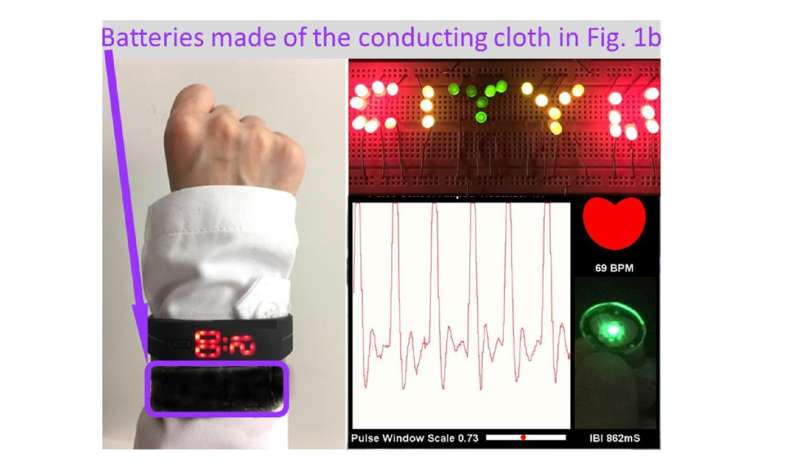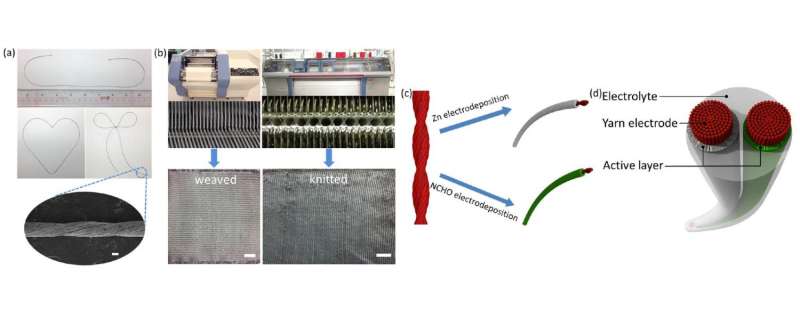A wristband made of cloth woven from the new yarn battery can power a watch (left), LEDs (upper right), and a pulse sensor (bottom right). Credit: Huang et al. ©2017 American Chemical Society
(Phys.org)—Researchers have fabricated rechargeable batteries by using highly conductive yarns that have a diameter and flexibility similar to that of a piece of cotton yarn. The new yarn battery can be woven into fabric and worn as a wristband or other type of clothing to power watches, LEDs, pulse monitors, and other small personal electronics.
The researchers, led by Chunyi Zhi, Professor of Materials Science and Engineering at the City University of Hong Kong, have published a paper on the new yarn battery in a recent issue of ACS Nano.
So far it has been challenging to develop high-performance wearable batteries due to a lack of materials that are both highly conductive yet strong and flexible enough to be woven into fabric. By addressing these issues, the new yarn battery exhibits one of the best performances to date, including a power density similar to that of supercapacitors, as well as an energy density and capacity similar to that of conventional batteries.
"We utilize highly conductive and weavable yarns to fabricate a yarn battery with state-of-the-art performance in terms of capacity, energy density, power density, and rate capability," Zhi told Phys.org. "The yarns are further weaved to make a wristband battery to power various personal electronics."
The core of the yarn battery consists of highly flexible micrometer-sized stainless steel filaments, onto which metals are deposited (zinc as the anode, nickel cobalt hydroxide as the cathode). A gel electrolyte is then coated around the entire piece of yarn.
The flexible, conductive yarn can be woven or knitted into cloth, which can later be used to power various electronic devices. Credit: Huang et al. ©2017 American Chemical Society
As the researchers explain, each material contributes to the good performance of the overall battery: The stainless steel yarn is strong enough to be woven and knitted by both machine and hand, and its conductivity also provides good long-distance electron transport. Synergistic effects between the nickel and cobalt metal ions boost the capacity and energy density values above those that would be possible using either metal alone.
By the numbers, the battery delivers power densities of 2.2 W/cm3, and 33 mW/cm2 for the whole battery. It has energy densities of 8 mWh/cm3, and 0.12 mWh/cm2 for the whole battery. All of these values are among the highest reported to date. The battery's capacity, 16.6 mAh/cm3, is the highest value so far reported for a fiber-based energy storage device, to the best of the researchers' knowledge.
After bending and twisting for 1,000 cycles, the battery retains 80% and 70% of its initial capacity, respectively. The researchers explain that the capacity loss is due to the formation of cracks on the electrodes when deformed.
To demonstrate the battery, the researchers wove the conductive yarn into a large conductive cloth, which could be used as a wristband battery to power electronic devices such as watches and LEDs. They expect that the yarn battery will have applications for wearable electronics, smart garments, and in healthcare in the future.
"Next we plan to make textile batteries that are washable, water-proof, and durable, in order to be closer to commercialization," Zhi said.
More information: Yan Huang et al. "Weavable, Conductive Yarn-Based NiCo//Zn Textile Battery with High Energy Density and Rate Capability." ACS Nano. DOI: 10.1021/acsnano.7b03322
Journal information: ACS Nano
© 2017 Phys.org

























